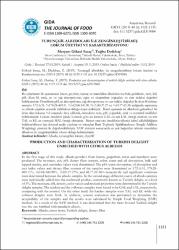Turunçgil albedoları ile zenginleştirilmiş lokum üretimi ve karakterizasyonu
Künye
Göksel Saraç, Meryem; Dedebaş, Tuğba (2019) Turunçgil albedoları ile zenginleştirilmiş lokum üretimi ve karakterizasyonu, Gıda Dergisi, 44 (6) 1121-1135Özet
GD19084.
ÖZ
Bu çalışmanın ilk aşamasında limon, greyfurt, turunç ve mandalina albedoları toz hale getirilerek, nem, kül,
pH, diyet lif, renk, su ve yağ absorpsiyonu, yığın ve sıkıştırılmış yoğunluk ve carr indeksi değerleri
belirlenmiştir. Örneklerin pH, su absorpsiyonu, yağ absorpsiyonu ve carr indeks değerleri ile diyet lif miktarı
sırasıyla 3.72-6.31, %178.28-469.11, %162.04-340.90, %15.00-27.27 ve %45.77-61.38 aralığında saptanmış
ve albedo çeşitleri arasında farklılıklar olduğu tespit edilmiştir. İkinci aşamada ise albedolar geleneksel bir
ürün olan lokuma %3 oranında ilave edilerek, örneklerin nem, pH, yoğunluk, renk ve tekstürel özellikleri
belirlenmiştir. Lokum örnekleri içinde kontrole göre en kırmızı GAL en sarı LAL örneği olurken, en sert
TAL ve KL en yumuşak MAL örneği olmuştur. Bunun yanı sıra örneklerin tüketici kabul edilebilirliğinin
belirlenebilmesi için duyusal analiz yapılmış ve sonuçları Basit Toplamlı Ağırlıklandırma (Simple Additive
Weighting) yöntemi ile değerlendirilmiştir. SAW yöntemi sonucunda en çok beğenilen ürünün mandalina
albedosu ile zenginleştirilmiş lokum olduğu belirlenmiştir. In the first stage of this study, albedo powders from lemon, grapefruit, citrus and mandarin were
produced. The moisture, ash, pH, dietary fiber content, color, water and oil absorption, bulk and
tapped density, and carr index values were determined. The pH, water absorption, oil absorption and
carr index values and dietary fiber content of the samples were determined as 3.72-6.31, 178.28-
469.11%, 162.04-340.90%, 15.00-27.27%, and 45.77-61.38% respectively and significant variations
were determined between the albedo samples. In the second stage, different source of albedo samples
were individually added into the traditional product, commonly known as Turkish delight, at a level
of 3%. The moisture, pH, density, color values and textural properties were determined in the Turkish
delight samples. The reddest and the yellowest samples were found to be GAL and LAL, respectively,
comparing with the control. On the other hand, the hardest samples were TAL and KL while the
softness delights were MAL. In addition, sensory evaluation was performed to determine the
acceptability of the samples and the results were calculated by Simple Total Weighting (SAW)
method. As a result of the SAW method, it was determined that the most favored Turkish delight
was the one fortified with mandarin albedo.
Kaynak
GıdaCilt
44Sayı
6Koleksiyonlar
- Makaleler [8]



















